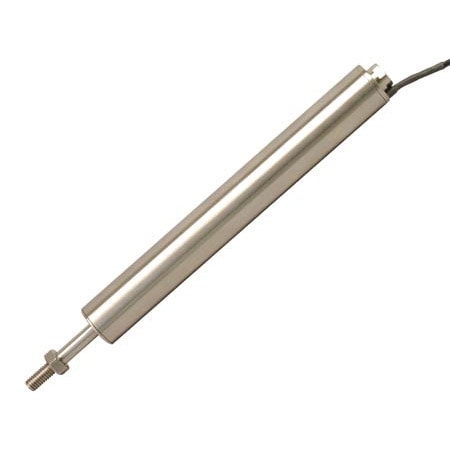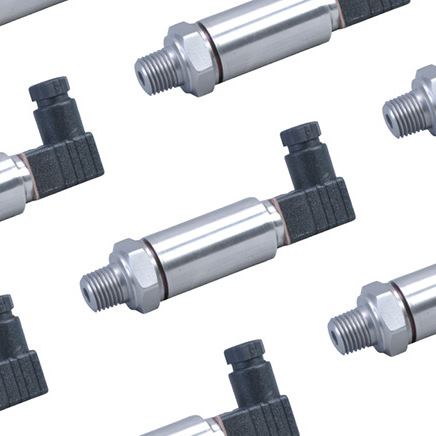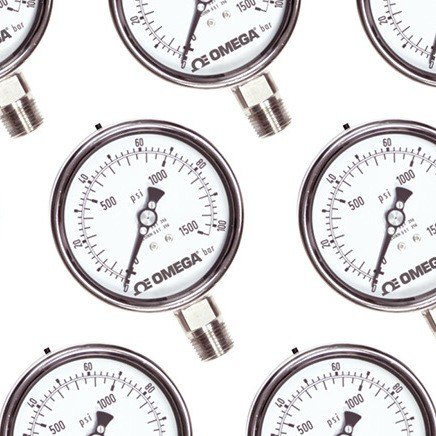A Linear Variable Differential Transformer (LVDT) is a highly accurate and frictionless sensor used for measuring linear displacement. These sensors convert linear motion into an electrical signal without any physical contact between core and coil and are popular across industrial sectors due to their high resolution, long lifespan, and robust performance in harsh environments.
How LVDTs Work
An LVDT, which is essentially a miniature transformer, consists of three wire-wound coils aligned along a cylindrical tube: one primary coil in the center and two secondary symmetrically wound coils on either side. Inside the tube is a movable ferromagnetic core connected to a push rod, which links to the object being measured.
As the object moves, the core shifts position within the coils. An alternating current (typically 1 to 10 kHz) energizes the primary coil, inducing voltages in the two secondary coils. The relative voltage difference between the two secondary coils changes depending on the core’s position, allowing precise measurement of linear movement.
Working Principle:
- An AC voltage is applied to the primary coil.
- The magnetic field induces voltages in the secondary coils.
- The position of the core changes the magnetic coupling, producing a differential voltage.
- This voltage is proportional to the core’s position and indicates linear displacement.
LVDT FAQs
| Q: How do LVDTs differ from RVDTs? | A: RVDTs (Rotary Variable Differential Transformers) measure rotational displacement, while LVDTs measure linear. |
| Q: Can LVDTs operate in extreme temperatures? | A: Yes, many models are rated for high- or low- temperature industrial environments. |
| Q: Do I need signal conditioning for an LVDT? | A: Typically, yes – especially if using raw AC power. Many systems include built-in electronics or require external signal conditioners. |
Types of LVDT Armatures
The armature is the movable core inside the LVDT. Choosing the right type is essential for optimal performance.
Captive Armature
- Guided through low-friction bearings
- Excellent for repeatable, high-precision measurements
- Used in materials testing and high-accuracy automation
Unguided Armature
- Freely floating and externally guided
- Allows minimal friction and wear
- Ideal where external guidance is already present
Force-Extended Armature
- Spring-loaded core
- Automatically extends to make contact
- Common in systems where the sensor must maintain contact with a moving surface
Key Advantages of LVDT Sensors
- Infinite Resolution - Limited only by signal conditioning electronics
- No Mechanical Wear - No contact between core and coil
- Reliable in Harsh Conditions - Resistant to shock, vibration, and contaminants
- Long Life - Often used in aerospace and high-cycle environments
Typical LVDT Applications
Industrial Automation
LVDT Sensors are commonly used to monitor and control the position of actuators and mechanical components. For instance, in robotic arms or automated production lines, LVDTs provide continuous feedback to ensure precise movements, proper alignment, and consistent quality control.
Aerospace & Defense
 In aerospace systems, LVDTs are used to track the position of control surfaces, landing gear, and cockpit instruments. Their ability to function reliably in high-vibration and extreme temperature environments makes them ideal for mission-critical applications in aircraft and defense vehicles.
In aerospace systems, LVDTs are used to track the position of control surfaces, landing gear, and cockpit instruments. Their ability to function reliably in high-vibration and extreme temperature environments makes them ideal for mission-critical applications in aircraft and defense vehicles.
Material Testing
Testing machines use LVDTs to precisely measure the deformation of materials under stress. As a tensile or compression force is applied to a specimen, the LVDT accurately tracks displacement to calculate strain, elasticity, and other material properties, ensuring compliance with testing standards.
Power Generation
 LVDTs are sued to monitor the position of turbine blades, governor systems, and dampers in power plants. This position feedback is critical for optimizing efficiency, ensuring safety, and enabling real-time adjustments in response to load changes or operational conditions.
LVDTs are sued to monitor the position of turbine blades, governor systems, and dampers in power plants. This position feedback is critical for optimizing efficiency, ensuring safety, and enabling real-time adjustments in response to load changes or operational conditions.
Choosing the Right LVDT Sensor
When selection an LVDT for a specific application, consider the following:
- Measurement Range: Travel distance required
- Environmental Conditions: Temperature, humidity, contaminants
- Electrical Output: AC or DC signal, need for signal conditioning
- Mounting Configuration: In-line, flange, or threaded options
DwyerOmega LVDT Solutions
LVDT Linear Position with Precision Tip
The LD500 Series LVDT Linear Position Sensor can be mounted to most production lines to do automatic gaging for quality, sorting, or go/no-go applications. The hardened steel shaft, O-ring seals and titanium pushrod can withstand most industrial conditions. The hybrid IC module provides a linear mV/V/mm (or inch) output which will interface with most standard dc input meters, recorders, data interfaces and industrial controllers.
- High Accuracy and Repeatability
- Ideal for Small Actuators
- Rugged Industrial Construction
LVDT Linear Position Sensors with AC Output
The LD320A Series of linear displacement transducers is the perfect combination of high accuracy and ruggedness to suit most general purpose applications. Not only do these products have up to 0.25% linearity, but they are also rated IP67 with a 304 stainless steel case that is hermetically sealed.
- Models with 0.25% Linearity
- Rugged Stainless Steel Body
- IP67 Environmental Rating
Contact a DwyerOmega Expert Today!





